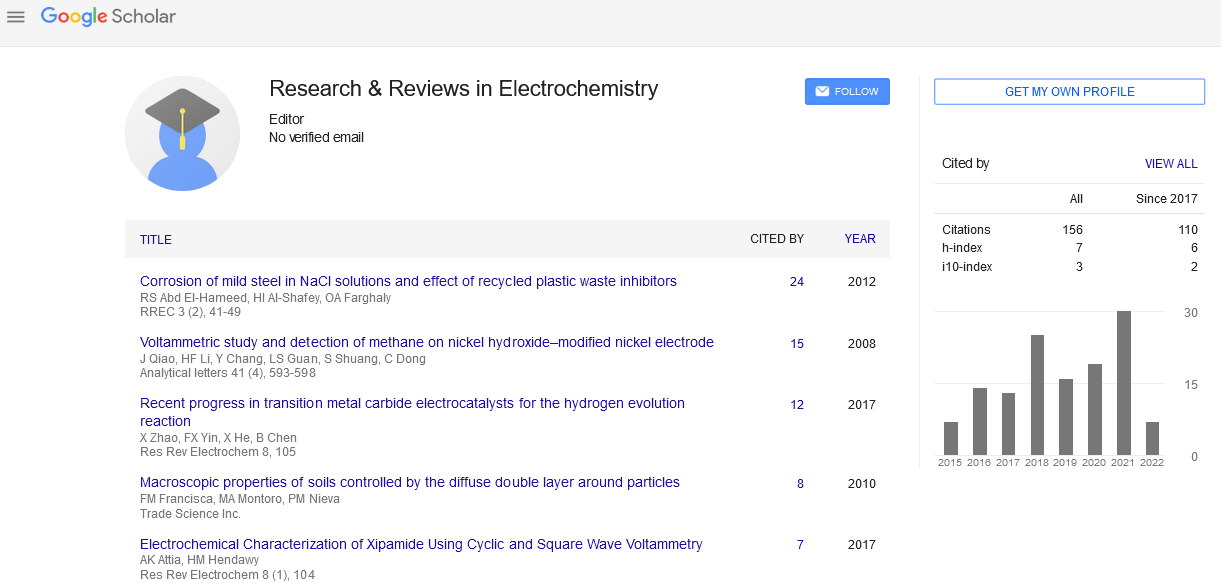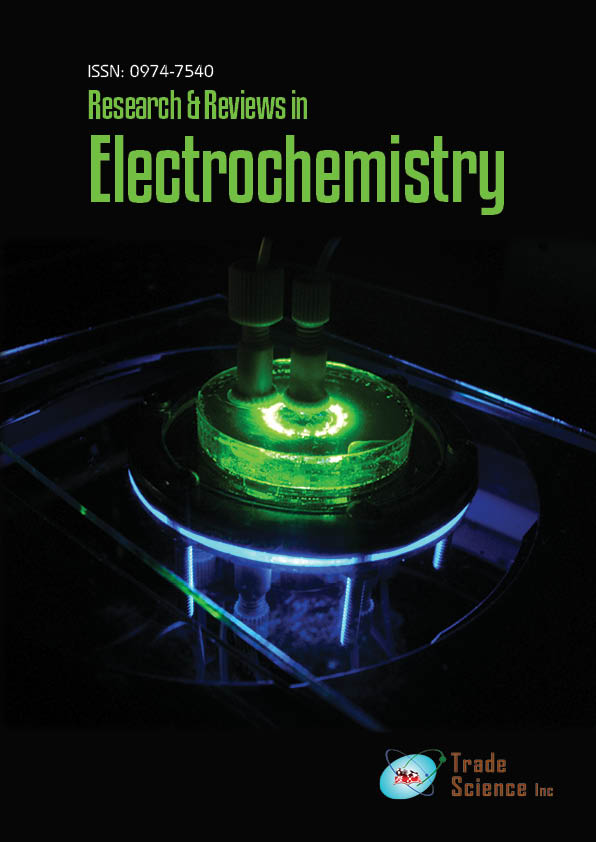Editorial
, Volume: 8( 1)Electrochemically Forced Degradation of Electro-Active Drugs on Carbon Nanomaterial Surface and its Pharmacokinetics: A New Challenge in Electrochemistry
- *Correspondence:
- Annamalai Senthil Kumar , Department of Chemistry Division, Nano and Bioelectrochemistry Research Laboratory, Vellore Institute of Technology, India, Tel: 0416-2202754; E-mail:askumarchem@yahoo.com
Received: March 14, 2017; Accepted: March 23, 2017; Published: March 27, 2017
Citation: Kumar AS. Electrochemically Forced Degradation of Electro-Active Drugs on Carbon Nanomaterial Surface and its Pharmacokinetics: A New Challenge in Electrochemistry. Res Rev Electrochem. 2017;8(1):e102.
Abstract
Editorial
Probing and analyzing precise drug reactions in physiological system is a challenging interest in the pharmacokinetics. It is not easy to predict the mechanism of the pharmaceutical drug reaction simply by established analytical instrumentation techniques like HPLC, Mass Spectro-photometry, UV-Vis and IR spectroscopes. Especially, detection of the intermediate generated or formed during the course of the drug reaction is very difficult to probe. It is expected that, since, physiological system consists of several redox active chemicals such as hemoglobin (Eo~-0.4 V vs Ag/AgCl), cytochrome C (Eo~-0.4 V vs Ag/AgCl), ubiquinone (Eo~0.2 V vs Ag/AgCl), dopamine (Eo~0.3 V vs Ag/AgCl), ascorbic acid (Eo~0.35 V vs Ag/AgCl), uric acid (Eo~0.4 V vs Ag/AgCl), which could generate redox signals and could transfer its electron to the drug system, detail for how the drug/s respond and interact with other carbon based physiological matters (Cell) is highly important to under the critical pharmacokinetics.
Forced chemical, photo-chemical, biochemical and thermal degradation based analysis of pharmaceutical drugs and certain organic compounds have great attention not only to understand the pharmacokinetics but also to support for the safety and efficacy of pharmaceutical and medicinal drugs. As per the Food and Drug Admiration Agency, FDA and International Council for Harmonization, ICH guidances, the requirement of stability testing data to understand how the quality of a drug substance and drug product changes with time under the influence of various environmental, chemical and biochemical factors are highly necessary for the process of new drug development. In general, data obtained from separation, identification and quantitation by various sophisticated instrumentation techniques are collectively used to the probe the degradation process and intermediates. Indeed, some of the intermediate products, which are short lived, couldn’t be identified by the conventional analytical techniques. I would like to introduce a new strategy for the forced degradation study of electro-active drugs which contains phenol and Quinone like moieties by electrochemical methodology using carbon nanotube or other graphitic carbon nanomaterial (graphene oxide and graphene etc.) modified glassy carbon electrode, (GCE/MWCNT) as a bio-mimicking model system to the biological matter (Cell), in consideration with carbon based skeleton and adsorbing ability of those materials with cellular systems. Owning to the pi-pi interaction between sp2 carbon and conjugated pi electrons (Scheme 1), carbon nanomaterial provides wonderful platform for strong adsorption of aromatic organic moieties on its surface and further to diffusion restricted electrochemical/electron-transfer reactions of the organic moiety nearly similar to electron-transfer reaction one occurs on cellular systems.
Owing to the ordered structure and conducting nature, the electron-transfer step happening on the carbon nanomaterial/drug interface can be easily probed in-sitully by simple voltammetric technique like cyclic voltammetry and pulse voltammetry in physiological solution (pH 7 phosphate buffer solution). As a preliminary study, we have examined the interaction of Phenol, Tetracycline, Amoxicillin, Penicillin, Ampicillin and various organic molecules on a CNT modified glassy carbon electrodes, designated as GCE/CNT, by electrochemical techniques [1-5].
As a preliminary study, our group has reported the interaction of some of the electro-active organic/pharmaceutical substances like phenol, Tetracycline, Amoxicillin, Penicillin, Ampicillin and various organic molecules on carbon nanotube modified glassy carbon electrodes in a physiological solution [1-5]. It has been observed that phenol, Tetracycline and Amoxicillin, which are having a phenolic functional group, get oxidized irreversibly either at +500 mV vs Ag/AgCl (case-I) or -450 mV vs Ag/AgCl (case-II) in pH 7 phosphate buffer solution to corresponding p-hydroxy phenol and its derivatives as surface-confined redox systems (Figure.1). These carbon nanomaterial (with graphitic structure) modified electrodes show a well-defined surface-confined redox feature at ~0 V vs Ag/AgCl. Parallel experiments with non-phenolic drugs, Penicillin and Ampicillin were failed to show any such electrochemical conversion reaction. It has been found that in the case-I mechanism, the phenolic group gets electro-oxidized directly as a phenolic radical and then to hydroquinone derivative. Whereas, in the case-II mechanism, the H2O2, which was formed at negative potential, -0.450 V vs Ag/AgCl, as an intermediate species, chemically interacted with the phenolic group and oxidized it as p-hydroxy phenol (hydroquinone) derivative. We believe, some of the electrochemical experimental results obtained here can be extendable or correlatable to pharmacokinetics of the above mentioned drugs. In further, detailed investigation using standard model/s to understand the pharmacokinetics system on both CNT and cellular system comparatively is necessary to further support the proposal.
Figure 1: Illustration for the interaction of phenol on cell (left side) and CNT (right side) surfaces and its possible electrochemical reaction.
References
- Kumar AS, Sornambikai S, Deepika L, et al. Highly selective immobilization of amoxicillin antibiotic on carbon nanotube modified electrodes and its antibacterial activity.J Mater Chem.2010;20(45):10152.
- Kumar AS, Sornambikai S, Venkatesan S, et al. Tetracycline immobilization as hydroquinone derivative at dissolved oxygen reduction potential on multiwalled carbon nanotube. J Electrochem Soc.2012;159(11):G137.
- Kumar AS, and Sornambikai S. Selective immobilization of hydroquinone on carbon nanotube modified electrode via phenol electro-oxidation method and its hydrazine electro-catalysis and Escherichia coli antibacterial activity.Electrochim Acta. 2012;62:207.
- Swetha P, Devi KSS, and Kumar AS. In-situ trapping and confining of highly redox active quinoline quinones on MWCNT modified glassy carbon electrode and its selective electrocatalytic oxidation and sensing of hydrazine.Electrochim Acta. 2014;147:62.
- Mayuri P, Kumar AS. Unexpected electrochemical transformation of aminobenzene sulfonic acid isomers to respective surface-confined-redox active quinones bypassing polyaniline on a MWCNT surface. ChemElectroChem. 2017;4(3):701.


